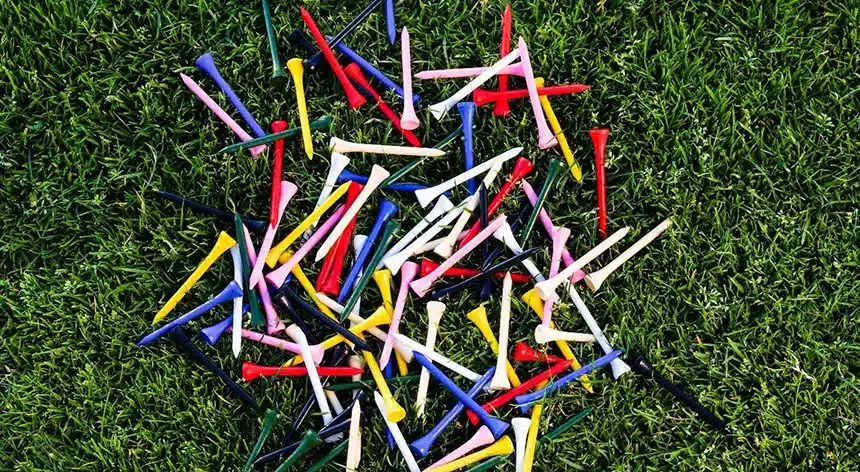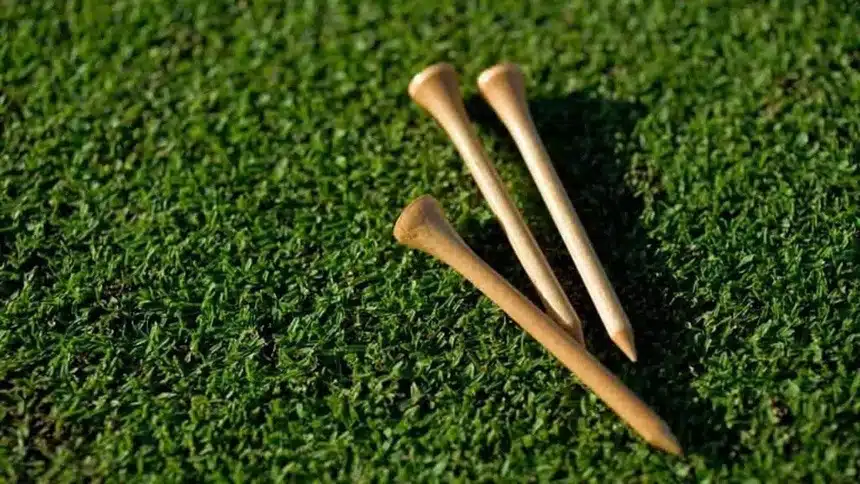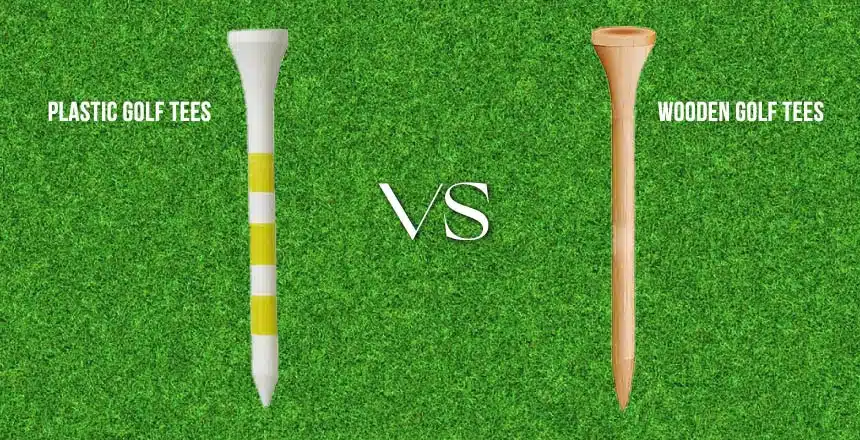You get them in different sizes and shapes now, but their purpose has remained the same. Even the comparison of wooden golf tees vs plastic golf tees is one that comes up much too often, along with how high or low to tee up the ball.
Should you purchase traditional wooden tees that have been and are still quite popular among PGA Tour players? Or instead, buy more flexible and maybe also durable plastic tees?
You need to factor in other things too, such as your swing plane, personal preferences, etc. when it comes to teeing up the golf ball.
In This Post
All the Different Types of Tees (by Material and Style)
Not all golf tees are made of the same material. Likewise, not all are designed in the same manner either. Each type of material and style presents its own advantages and disadvantages. But we’ll get into that later, first let me just tell you all the different varieties of tees used for golfing.
Golf Tees by Material
- Plastic tees
- Wood tees
- Rubber tees
- Bamboo tees
Golf Tees by Design
- Brush
- Anti-slice
- Zero friction
- Standard
Do Golf Tees Make A Difference?
The importance of golf tees cannot ever be overstated because tees are a must, particularly when you’re hitting your driver and irons. In the case of a driver, meaning for your off-the-tee shots, it’s necessary for teeing up the golf ball, right?
To tee up the ball requires you to make contact with it using the clubface during the upswing part of your golf swing. Only this way does the launch angle of the shot and, ultimately, the distance increase.
As for when playing shorter holes, which you normally do with an iron. So let’s say you’re using the iron from that tee box, thus the ball position should be raised with the help of a tee. No doubt, the elevation here also elevates your chances of achieving that clean, solid strike which prevents fat or thin shots.
What Golf Tees Should You Be Using, Plastic or Wood?
Why Use Plastic Golf Tees?

All tees made from plastic have the same length and shape. The best plastic golf tees produce less friction on impact. They’re also those that have a completely anti-friction design. These kinds of plastic tees minimize resistance i.e. friction by supporting the golf ball at the top of the three prongs. Less contact surface means less friction!
You surely get more durability and flexibility with plastic material, in comparison to wood. Plastic tees, after all, do not break. They may bend, but break they do not! And this leads me to…
Why Avoid Using Plastic Tees?
Precisely because a plastic tee, over time, will bend. These types of tees are nearly unbreakable, but bend resistance is not a part of that exceptionally durable character. And when the tee bends, it becomes tougher to press it into hard ground.
And also because, for reasons already known to us, plastic is no friend to planet Earth. The material takes a long, long time to break down. So why not choose biodegradable tees instead!
Why Use Wooden Golf Tees?

Certainly, traditional (biodegradable) wooden tees are more Earth-friendly. And if you get the best wooden golf tees, you also get exceptional material strength. Do not expect these kinds of tees to bend or break at any point unless the turf you’re playing on is too hard.
Another upside to picking wooden tees over their plastic counterparts is that the former is relatively more affordable as well.
Why Avoid Using Wooden Tees?
Wood material means its natural color will camouflage with the background color. As a result, it might be a little tricky and difficult to find wooden tees on grass, even more so when the grass is dry.
And then there’s the possibility of a wooden tee breaking when you force it into very hard, dry turf.
What Type of Golf Tees Do Pros Use and Why?
Professional golfers go for wooden tees for their PGA Tour tournaments. Except if the player is obligated, by contract, to choose a specific brand that manufactures plastic tees.
Which Material of Golf Tees Is More Prone to Breaking?
The more unbreakable kind is the wooden tee. However, plastic tees also break, but only when subjected to bending too much or too often.
Does the Size of Golf Tee Matter?
Typically, tees are sized between 2-1/4” and 4”, with 2-3/4” being the most common length. As for the legal maximum size of golf tees, it’s 4 inches.
The thing is that tee length has a lot to do with your angle of attack. A steeper golf swing, for instance, works better with longer tees and a shallower one with shorter tees. Here’s why…
When the ball position is higher, you can get your drives to fly higher and longer as a result of hitting the golf ball on your upswing.
How Does Tee Height Affect Performance?
Tee the golf ball low and see how the trajectory produced is penetrating and low, which will and does indeed lead to distance loss. Although you won’t see this happening when playing on golf courses, links-type, that give you tons of rollout.
Then tee the ball at a good height and now notice both contact and flight path. Teeing up high means contact with the golf ball is made on your upswing. Thus, contact created between the ball and upper clubface of your driver, which results in producing the distance-boosting combination of higher apex and less spin.
But if you end up teeing up too high, contact will be made on the clubface’s lower end and golf ball’s bottom half. The outcome of this is excessive spin rate and reduced distance.
Why Do You Keep Breaking Golf Tees?
The most common reason or cause here is contact produced directly between tee and clubface. A too steep swing path or angle of attack means you’re making contact on the downswing i.e. at the bottom of the arc. That’s how and why you end up breaking your tees!
Instead, you should be hitting that golf ball during your upswing. That way, you’re sweeping the ball right off the tee, leaving the latter in one piece in the ground.
What Is the Correct Tee Height for Woods, Hybrids, and Irons?
Most importantly, tee height depends on your golf swing plane. Ultimately, what feels more comfortable and boosts confidence when you’re addressing the ball – these factors matter the most above all else.
Also, remember that when you tee up, you’re actually hitting better shots and preventing unfavorable lie conditions. Just don’t tee up too high!
Correct tee height for drivers is usually either 3-1/4 inches or 4 inches – the higher length being more suitable for large-headed drivers. While hybrids and irons don’t really need that additional height. The tee, when using hybrids and irons, should just place the golf ball above grass so its blades don’t get caught between the clubface and ball.
What Golf Tees Win Then, Plastic or Wood?
Both plastic and wooden tees are good to use, the former being more durable and flexible whereas the latter is a more traditional, Tour-player-preferred version. Based on that alone, it’s the wooden tee that emerges as the top performer.
The thing about wooden tees is that it’s more environment-friendly, plus it doesn’t bend out of shape like plastic tees. There’s no way that a wooden tee will affect your performance or the environment, and that should settle the debate between plastic vs wooden tees for golf.

